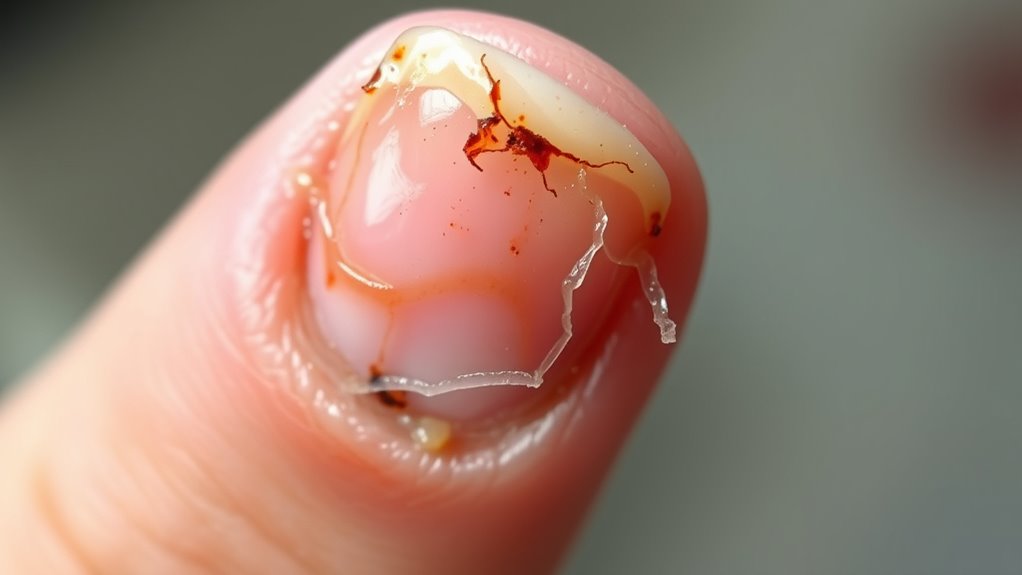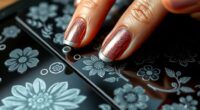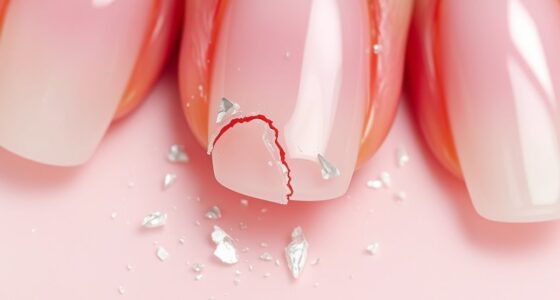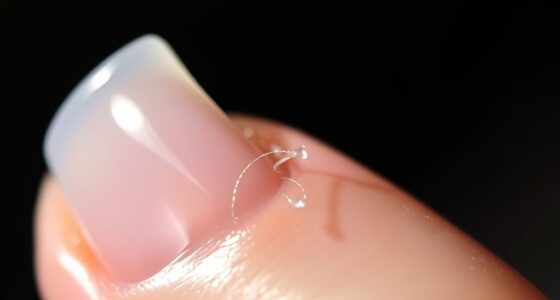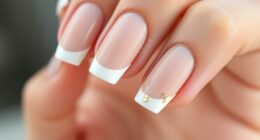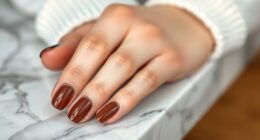If nail glue bonds your skin or nails incorrectly, stay calm and use gentle techniques. Soak a cotton ball in acetone-based remover and hold it against the glue for several minutes to soften it. Avoid forcing or scraping, as this can cause injury. Be patient, repeat if needed, and moisturize afterward. If stubborn glue persists or you experience pain, it’s best to consult a professional. Keep going, and you’ll discover more tips to remove it safely.
Key Takeaways
- Use acetone-based nail polish remover with a soaked cotton ball to soften and gently lift the glue.
- Avoid forceful peeling or scraping to prevent skin or nail damage; patience is key.
- Perform a patch test with acetone first to check for skin sensitivity before full removal.
- Seek professional help if DIY methods fail, the glue is stubborn, or irritation occurs.
- Keep the area moisturized after removal and monitor for redness, swelling, or pain.
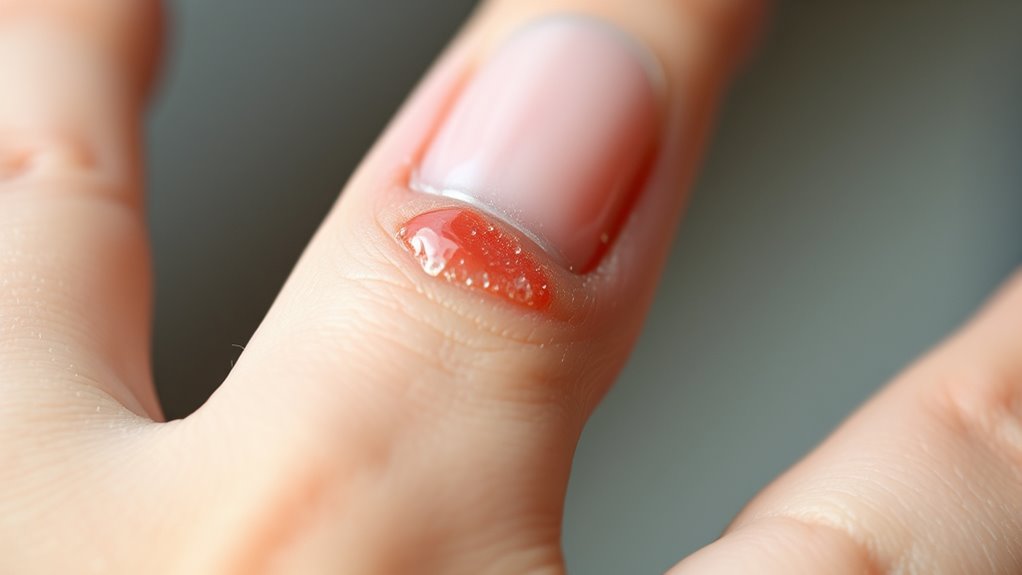
Removing nail glue can be a delicate process, but with the right techniques, you can do it safely at home. When nail glue accidentally gets on your skin or nails, it’s tempting to grab the nearest remover or peel it off, but rushing can cause irritation or damage. Instead, start with some DIY remedies that are gentle yet effective. Soak a cotton ball or pad in acetone-based nail polish remover, then hold it against the glue for several minutes. This helps soften the adhesive, making it easier to gently lift away. You might need to repeat this process a few times, especially if the glue has dried thoroughly. Avoid forcing the glue off, as this can tear your skin or damage your natural nails.
If DIY remedies don’t do the trick after a few attempts, professional removal may be your best bet. Nail technicians or dermatologists have access to stronger, specialized products designed to dissolve stubborn adhesives safely. They can also minimize the risk of skin irritation or nail damage that might happen if you try to remove the glue improperly at home. Remember, not all glues are created equal—some are more resistant and require professional tools and expertise to remove.
When attempting to remove nail glue on your own, be cautious. Use a gentle approach, and don’t pick or scrape the glue forcefully. Scraping can cause pain, bleeding, or even infection. Instead, keep the area soaked and wait patiently for the glue to loosen. If your skin becomes red, swollen, or painful, stop immediately and consider seeking professional help. Applying moisturizer or cuticle oil after removal can soothe your skin and prevent dryness or cracking.
In some cases, you might try natural remedies like warm soapy water or petroleum jelly, but these are less effective for hardened glue. They can help loosen the bond slightly but usually won’t remove stubborn adhesives. For best results, sticking with acetone-based removers is recommended, yet always do a patch test first to ensure your skin doesn’t react negatively. Additionally, understanding proper removal techniques can help prevent accidental skin or nail damage.
Ultimately, knowing when to switch from DIY remedies to professional removal is key. If you’ve tried soaking and gentle peeling without success, or if the glue is in a hard-to-reach area, don’t hesitate to consult a professional. They have the experience and tools to remove nail glue safely, saving your skin and nails from unnecessary damage. Remember, patience and gentle methods are your best allies in this process.
Frequently Asked Questions
Can Nail Glue Removal Damage My Natural Nails?
You might worry that removing nail glue could harm your natural nails, but if you take proper precautions, the risks are minimal. Inadequate removal can weaken your nail health or cause damage, especially if you scrape or peel aggressively. To avoid removal risks, use gentle methods like acetone or consult a professional. Being careful guarantees your nails stay healthy and strong, even after removing stubborn glue.
Is It Safe to Use Acetone Regularly for Glue Removal?
Ever wondered if using acetone safety for frequent use is okay? While acetone is effective for removing nail glue, regular use can dry out your skin and weaken your natural nails. It’s best to limit its use and opt for gentle alternatives when possible. If you choose to use acetone frequently, make sure to moisturize afterward and avoid prolonged exposure to protect your skin and nails from damage.
How Long Does It Take for Skin to Recover After Glue Removal?
You might wonder how long skin healing takes after removing glue. Recovery time varies depending on the extent of the irritation or injury, but generally, minor skin damage can heal within a few days to a week. To support recovery, keep the area clean, moisturized, and avoid further irritation. If redness, swelling, or pain persists, consider consulting a healthcare professional for proper care and to guarantee ideal skin healing.
Are There Any Home Remedies for Stubborn Nail Glue?
When dealing with stubborn nail glue, you might wonder about DIY remedies and natural solutions. You can try soaking your nails in warm, soapy water to soften the glue, or use acetone-based nail polish remover for quick results. Gentle scrubbing with a soft brush can also help, but avoid harsh tools. Natural solutions like coconut oil or olive oil can loosen the glue over time, making removal safer and easier.
What Should I Do if I Experience an Allergic Reaction?
If you experience allergic symptoms like swelling, redness, or difficulty breathing, seek emergency treatment immediately. Stop using the nail glue and rinse the affected area with plenty of water to reduce irritation. Take an antihistamine to help with allergic reactions, but don’t delay professional medical help if symptoms worsen. Acting quickly is essential to prevent severe complications and guarantee your safety.
Conclusion
So, next time your nail glue turns into a stubborn ex, remember you’re not helpless. Grab some acetone, patience, and maybe a dash of humor, because let’s face it—nothing says “professional” like peeling glue off your skin. Who knew that a tiny tube could cause such drama? Stay calm, stay clever, and save yourself from the beauty blunder of the century. After all, your skin isn’t a craft project—it’s your body.
